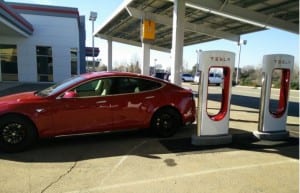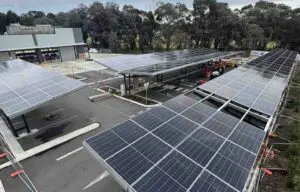AGL Energy has announced plans to offer its electricity customers a $1 a day “all you can eat” electric vehicle charging service, under a new deal that will be launched by the retailer in November.
The new product was announced by AGL CEO Andy Vesey at the Australian Energy Week 2016 conference in Melbourne on Tuesday, and signals yet another push by the big utilities to engage with the new technologies that threaten to disrupt their traditional business models in coming years.

Vesey said the deal meant that AGL customers with an EV – such as a Tesla, a BMW or a Nissan Leaf – and an AGL digital meter could use it as a home charging station, 24 hours a day for just $1, with the emissions fully offset.
“If you’re an AGL customer, or become one, then we will provide charging for electric vehicles, $1 a day, all you can eat,” Vesey told the conference at the end of his keynote address.
“So for a dollar a day if you have an electric car and you have an AGL smart meter… you can get energy for that car, as much as you want, 24 hours a day, for a dollar.”
Vesey said that the full details of the EV deal would be revealed when it was launched on November 1. It is one of a number of new initiatives AGL has launched in the past 12 months, including cheap offsets and battery storage products, although this one has the added incentive of increasing load for the utility.
“Growth is important,” he told the conference. “We think doing things to encourage electric vehicles for consumers is important.
“We can’t make the cars. We can’t buy the cars … But we certainly can enable our customers to make the purchases.”
Load is important for the big utilities, particularly those like AGL with major base load generators, which are facing declining demand as homes become more efficient, add more rooftop solar, and as national and state-based renewable energy policies reduce demand from the grid and squeeze out coal generators.
Vesey, who spoke at the Energy Week conference after federal energy minister Josh Frydenberg – who delivered a speech heavy on the federal government’s pet theme of “innovation” – said that technological innovation was not the key to shifting Australia’s energy network to a low-carbon future.
“The single biggest issue we have blocking this transition, from a wholesale perspective, is the fact that we have a national energy market that is overbuilt,” Vesey said.
“Supply way exceeds demand… you need to make room for new investments, because private capital is not going to take the risk.
“The more the wholesale networks can carry it, the more likely that it is going to be built.
“So when you need to talk about getting supply and demand balanced, that takes clever thinking and leadership.”
Vesey also told the conference that AGL, which among other fossil fuel assets owns the Loy Yang coal-fried power plant in Victoria, had been advocating for the orderly exit of plant in Australia.
“Because the alternative is ugly,” Vesey said. “It’s the disorderly exit. And I can tell you, it’s one or the other, because we’re not going to stay where we are.”
“When we think about orderly transitions, we do need to be clever… There was always this question of paying for closure; I’m not a fan of paying for closure,” he said.
“I’m a fan of investors dealing with the consequence of their investments, good or bad.
“What we need is a holistic approach… (such as) a broad industry-wide securitisation program.
“This was done many times in many markets,” he said, noting the example of the deregulation of the US nuclear market.
“And it can be done here. It’s a manageable problem. But what we are saying here is that the move needs to be towards an orderly transition, because the cost of a disorderly transition is significant.
“The idea that you can transform the entire electric infrastructure in the market, by itself, I think is a very difficult one.”
Vesey was also keen to reiterate the inherent value of the existing electricity network, as well as his view that a future scenario where the energy market becomes a mass of independent micro- and mini-grids was highly unlikely.
“The nonsense, and I’ll say it again, the nonsense of the utility death spiral and everybody getting off the grid makes no sense.
“It’s a much more expensive, less efficient outcome than this marvellous machine we have in this world called the network,” he said.
“The bigger (the) network, the greater the efficiency. And the greater the efficiency the lower the cost and the environmental impact, regardless of the infrastructure.
Later, in the CEO Q&A session, Vesey continued along this line, arguing that Australia’s first 5GW of solar rooftops were, essentially, enabled by the grid.
“If I was a consumer, and even though I might have the capability to go off the grid, I’d have to say, with current tariffs I have a free option, I can stay on it. Because I don’t know where the world is going, and there might be some other technology that I can get great benefit out of because I have this connection.
“It just makes sense that if (consumers) don’t know what’s happening (with future technology), that grid, that network …has tremendous value.
“The question is how do we bring that into play and understand it and how does that inform our policy making.”
On disruption in the energy industry, Vesey quoted Canadian science fiction writer William Gibson, who said “the future is already here, it’s just not evenly distributed.”
“The law of disruption is that technology provides us with capabilities exponentially, but social systems grow linearly,” said Vesey.
“We have technologies that allow us to do, today, things which our systems of regulation and law do not let us do, because we don’t know the right policy frameworks to liberate those capabilities. But if you look around you can see it.”










